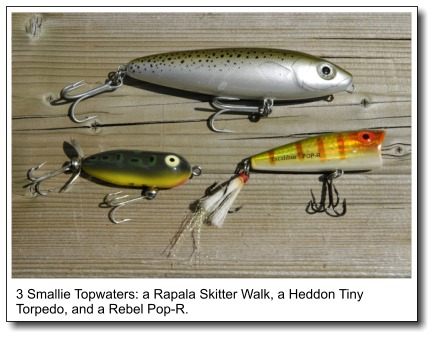|
 Three
Foolproof Topwater Tactics for Smallmouth Bass Three
Foolproof Topwater Tactics for Smallmouth Bass
By Tim Allard
This article concentrates on three foolproof topwater baits for
smallmouth bass: prop baits, poppers and cigar-style lures. Each has
a different action on the surface and all regularly fool smallmouth
bass.
Prop Baits:
These lures feature one or more blades on their bodies. The blades
spin during the retrieve, displacing water and creating a metallic
gurgling sound. Some models only have back blades, like Heddon’s
Torpedos, while others feature both front and back blades, like
Cotton Cordell’s Crazy Shad.
These baits excel in calm or slightly rippled water conditions.
There are many ways to fish them. One is a stop-and-go retrieve.
Experiment with short and long twitches. Twitch the bait so it
spurts forward. Then let it rest for a few seconds before beginning
the twitching retrieve again.
An alternative is retrieving the bait on a slow crawl. Move it just
enough to keep the blades spinning. This creates a wake and the
straight trajectory makes it easy for smallmouth to locate and hit
the lure.

Poppers:
Poppers are lures with a concave nose. The nose cups and spits water
when the bait is twitched forward, making a “bloompsh” sound. Some
examples of these baits are: Berkley’s Frenzy Popper, Heddon’s Pop’n
Image, Rapala’s Skitter Pop, and Rebel’s Pop-R.
The sound and commotion poppers cause attract smallmouth from a
significant distance. I regularly use poppers to hunt deep-water
smallmouth during dawn and dusk. Like prop baits, poppers do well in
calm or slightly rippled water conditions.
There is no right or wrong way to work this bait as long as it’s
popping every so often. To cover water, bring the bait in with a
series of two to three twitches, followed by a brief pause, before
beginning again. This retrieve is suited for aggressive fish.
Slowly work a popper when trying to coax neutral fish to bite. After
casting the bait, let the splash rings dissipate after it hits the
surface. Next, slowly retrieve it one or two twitches at a time
followed by long pauses. This method requires patience, but if
you’re in an area that holds big fish, it can triggers the most
reluctant ones to bite.

Cigar-Style Baits:
These baits are another productive surface lure. To fish them you
need to be able to “walk the dog” (i.e., cause the bait to swim back
and forth). This action is achieved by the angler twitching the rod.
Here’s how to do it.
Begin by twitching the rod tip downward. Immediately follow this by
raising the rod tip towards the bait to create slack in the line.
The twitch causes the bait to move to one side, the slack line lets
it continue to glide. Twitch the rod again to cause the bait to turn
and glide in the other direction. Continue twitching the rod tip up
and down. This makes the bait walk back and forth on the water,
while maintaining a fairly straight line towards the rod tip.
The sound and water disturbance caused by this presentation evoked
aggressive hits from smallmouth bass. The bait can be used in calm
conditions, but it’s just as deadly in waves when smallmouth are
aggressive. Smallies have no trouble chasing a bait through the
crest of a wave to crush it.
Rods, Reels, and Line:
For the most part, I prefer to toss smaller, lighter topwaters (like
prop baits or poppers) on spinning gear. I get better distance out
of these rods. When “walking the dog” I use a baitcast rod; I find
the grip on this set-up easier to twitch baits downward.
The rod itself should have some softness in the tip. Use too stiff a
blank and it won’t bend towards the fish during the strike, equating
to poor hook-up percentages.
When it comes to line, you can use any kind as long as you balance
it with the rod’s action and reel drag. Monofilament can be good for
prop baits and poppers, especially if they’re small. Mono floats,
helping you get the right action out to the bait. It also stretches,
which again can help with hook-up ratios on topwaters as it allows
fish to inhale a bait. Fluorocarbon and super lines can also be
used, but not on too stiff a rod. Again, these lines won’t impact
the action of baits too much, but may reduce your hook-up
percentages if you use too stout a rod.
Odds are you have at least one of these surface baits in your tackle
box. Consider increasing your topwater roster by adding another one
or two. Not all topwaters are created equal, sometimes smallmouth
prefer a walk-the-dog bait, while in other conditions it might take
a popper to call them up. Lastly, remember to wait to feel the
fish’s weight before you set the hook. Set on the splash and you’ll
frequently miss fish.
 Editors
note: Hammerhead lures is producing a new line of shallowwater
and topwater baits for bass. These lures are incredible.
To have a bettter look at thier product line
click here! Editors
note: Hammerhead lures is producing a new line of shallowwater
and topwater baits for bass. These lures are incredible.
To have a bettter look at thier product line
click here!
|